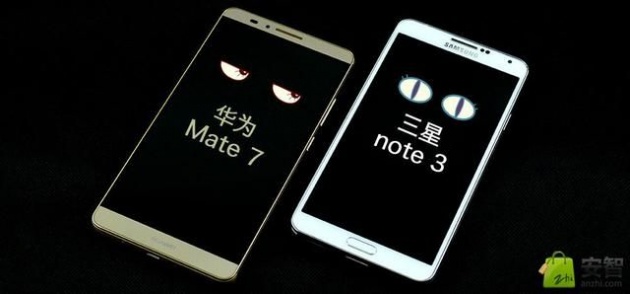
When the average Joe prepares to buy a cellphone, he either cannot afford a flagship phone or believes that a phone that costs around 200 USD may not be good enough. In other words, choosing a cellphone is like deciding what to eat for lunch and dinner. How do you choose the best cellphone for yourself? Actually, there are some pretty good choices among phones right now in the 500 USD range. There are so many phones out there with great specifications and good-looking appearance. If you are looking for a phone that costs around 500 USD, then your best choices are either the Huawei Mate 7 or the Samsung Galaxy Note 3.
As Huawei’s big-screen hit of the year, the Mate 7’s specs make it one of the best flagship phones this year. Although the Note 3 international version was last year’s flagship phone, a year after its launch, the price has already gone down to 500 USD. It uses the Samsung Exynos 5 Octa 5420 ocat-core processor, and, like the Mate 7, has 3GB. As you can see, it’s not so easy choosing between them.
Appearance
 The Samsung Note 3 sports a 5.7-inch Super AMOLED screen with a 1080p resolution. The Mate 7 continues to use its predecessor’s big screen and also a 1080p resolution with a few changes. Now, it is made of space-level/aluminium alloy.
The Samsung Note 3 sports a 5.7-inch Super AMOLED screen with a 1080p resolution. The Mate 7 continues to use its predecessor’s big screen and also a 1080p resolution with a few changes. Now, it is made of space-level/aluminium alloy.
The Huawei Mate 7’s black screen looks better than most big screen phones right now because the black frame and metal edge go so well together that it almost looks like it has a very thin chassis. As for the Note 3, Samsung added a metal frame on the edge making it wider than the Mate 7’s screen.
As for the camera, the Huawei Mate 7 sports a 5mp front-facing camera which is better than the Samsung Note 3’s 2mp front-acing camera.
Both phones sport a 13mp rear-facing camera from Sony.
The Huawei Mate 7 is the company’s first smartphone to have a fingerprint sensor which was provided by US-based Authen Tec like the iPhone 5s. Actually, you can even say that Huawei took it one step further, with its fingerprint sensor even surpassing the iPhone 5’s.
Samsung is not as fortunate as the Note 3 does not have a fingerprint sensor.
The Huawei Mate 7 supports dual-SIM cards which is the best choice for a unibody phone like this. Unfortunately, you need a tool to open the SIM dish. The Note 3, on the other hand, has a detachable rear case which is very convenient, especially for those who regularly change SIM cards.
3.55mm earphone jack
Regarding data transmission, the Samsung Note 3 has a USB 3.0 port. This port is also supports USB 2.0 connection. After testing both phones, the Note 3’s data transmission speed is faster than the Mate 7’s.
The Mate 7′s body is made of aluminum while the top and bottom ends are made of plastic to help the antennas to handle signals better. It has a more comfortable texture than the Note 3’s rear case. However, the Note 3’s rear case is detachable and the battery is replaceable. A lot of people may not like the fact that it is made of plastic but the only company of making a plastic chassis like this is Samsung.
 The Mate 7 has an NFC sensor near the camera.
The Mate 7 has an NFC sensor near the camera.
The Note 3 has support for wireless charging but it should be compatible with a rear case that has this function.
Regarding thickness, the Huawei Mate 7’s is 7.9mm while the Note 3’s is 8.3mm, but because the Huawei Mate 7’s rear case is made of metal, it is a bit heavier than the Note 3.
OS Performance
The Samsung Note 3’s lock interface and desktop
The Huawei Mate 7’s lock interface and desktop
The Samsung Note 3’s notification bar and shortcut icons
The Huawei Mate 7’s notification bar and shortcut icons
Samsung Note 3’s settings interface and OS information
Huawei Mate 7’s settings interface and OS information
Antutu benchmark scores: Huawei Mate 7 (43173), Samsung Note 3 (42007)
Huawei Mate 7’s video compatibility test results. The checks mean that they are supported. The last column shows video results. Most are normal while some do not have sound and images.
Samsung Note 3’s video compatibility test results. It does not have as much formats that work normally as the Mate 7’s.
It’s more comforting using the Mate 7’s Android 4.4.4-based EMUI 3.0 but the Note 3’s OS (also based on the Android 4.4.4) also offers a good drawing and writing experience with the S-Pen.
Screen performance
The Huawei Mate 7 sports a 6-inch 1080p LCD resolution with JDI and Gorilla Glass while the Samsung Note 3 international version sports a 5.7-inch 1080p screed with Super AMOLED and Gorilla glass.
The left bar represents the Huawei Mate 7 while the right bar represents the Samsung Note 3.
Red
Green
The colors are more beautiful in the Note 3 because of its Super Amoled glass but look a bit more bluish. The colors are more accurate however in the Mate 7’s LCD screen. In a purely black environment, Super Amoled is unbelievable because the screen does not let out light, and becomes simpler and cruder, while light leaks out in the Mate 7’s screen.
Endurance
When it comes to endurance, it’s a tie because the Mate 7’s battery is bigger than the Note 3’s. The Mate 7 has already caught up to Samsung when it comes to hardware and power management.
Photo comparison
Mate 7 Note 3
Note 3 Mate 7
Mate 7 Note 3
Note 3 Mate 7
Mate 7 Note 3
Note 3 Mate 7
Mate 7 Note 3
Note 3 Mate 7
Mate 7 Note 3
Note 3 Mate 7
Mate 7 Note 3
Note 3 Mate 7
Mate 7 Note 3
Note 3 Mate 7
Mate 7 Note 3
Note 3
Looking at the daytime photos, it’s hard to tell which phone takes better pictures. Same goes for purity and color. The way both phones take night photos is another story. The Mate 7 does a good job maintaining small details in the photo as well as preventing noise.
Conclusion
As Huawei’ s flagship phone of the year, the Mate 7 is an excellent phone in all fronts, but as the third generation flagship phone of Samsung’s Galaxy Note series, the Note 3 is also great. Both phones have their pros and cons. Which would you rather buy?
Source: http://www.gizmochina.com/2014/10/07/huawei-mate-7-vs-samsung-galaxy-note-3-international-version-a-comparison/





























